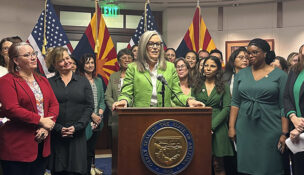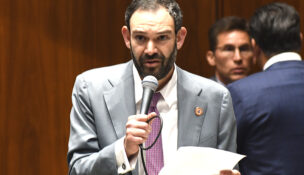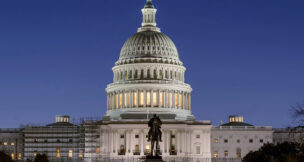Panel votes to require big increase in energy from renewable sources
Arizona Capitol Reports Staff//November 3, 2006//[read_meter]
Panel votes to require big increase in energy from renewable sources
Arizona Capitol Reports Staff//November 3, 2006//[read_meter]

Looking to the sun
Sean Seitz (left), president of the Arizona Solar Energy Industries Association, a nonprofit trade group, speaks to reporters Oct. 27 shortly before a Corporation Commission meeting on mandating greater use of renewable energy, including solar power.
The Arizona Corporation Commission on Oct. 31 approved rules requiring utilities to generate 15 percent of their energy from renewable sources, such as sunlight and other “green” energy sources.
Chairman Jeff Hatch-Miller and Commissioners Bill Mundell, Kris Mayes and Barry Wong voted to require regulated electric utilities to generate 15 percent of the total megawatts sold from renewable resources by 2025. Commissioner Mike Gleason voted against the rules, citing concerns over the costs of meeting the sharply higher standard, grid reliability and specific changes he sought to make the rules more precise.
Because the substantive changes included in some proposed amendments would have required the rulemaking process to start again, the commissioners stopped short of passing several possible changes.
Some minor, more technical, amendments were approved. The amendments related to implementation plans, reporting requirements and compliance steps.
For 2006, utilities must generate 1.25 percent of retail energy sold from renewable resources.
The Commission’s Renewable Energy Standards allow utilities to use solar, wind, biomass, biogas, geothermal and other similar technologies to generate “clean” energy to power Arizona’s future. The rules package outlines what technologies qualify and allow for new and emerging technologies to be added as they become feasible.
The new requirements were hailed by the Arizona Public Interest Research Group as a historic step toward reducing pollution and improving the economy.
“More renewable energy in Arizona means more jobs and less pollution,” Diane Brown, the organization’s executive director, said. “The state’s economy and the public’s health will benefit from increased renewable energy.”
Sean Seitz, president of the Arizona Solar Energy Industries Association, said the results should be an increase in the use of solar power by the utilities, which he says will double or triple the 900 Arizona jobs in the solar energy industry in just a few years. The move to renewable energy sources will also reduce the dependence on fossil fuels, like natural gas, which have seen dramatic price increases in recent years.
“We’re at the mercy of outside forces when it comes to our energy future in Arizona,” he said.
Taxpayers group: Cost outweighs returns
However, the Arizona Federation of Taxpayers says the cost to implement the renewable energy technologies far outweighs the returns.
“Virtually every renewable source of energy is significantly more expensive than conventional sources,” said Tom Jenney, the group’s executive director. “If this were gasoline at the pump, instead of kilowatt-hours, we would be talking about $10 a gallon.”
In addition to utility-owned projects, such as Tucson Electric Power’s large solar installation in Springerville, the changes also require a growing percentage of utilities’ total resource portfolios to come from distributed generation — residential or non-utility owned installations. The distributed energy requirement starts at 5 percent of the total portfolio in 2007 and grows to 30 percent of the total renewable mix after 2011.
In many cases, distributed generation installations — such as a large solar installation on the roof of a shopping mall, or solar panels at someone’s home — qualify for utility rebates or state and federal tax breaks that offset some of the upfront costs.
Unlike other states that set aggressive standards but grandfather in or give credit for existing projects, Arizona’s Renewable Energy Standards are focused on adding new generation and taking advantage of emerging opportunities, a spokeswoman for the Corporation Commission said.
If a utility does not meet the standard, it can apply for a waiver and go through a hearing, though the commission may still assess a penalty for non-compliance.
To help offset the increased cost of meeting the more aggressive standard, the current Environmental Portfolio Surcharge paid by consumers will change. Each utility will have to file a request to recover the cost of installing and operating its renewable resources. The total amount of each utility’s proposed surcharge is unknown until the utilities submit a proposal to the commission. Each utility is also required to file an annual plan outlining the steps it is taking to meet the new standard.
The proposed “sample tariff” associated with the Renewable Energy Standards would increase the residential surcharge from a cap of $0.35 to $1.05.
The Renewable Energy Standards were formerly known at the Environmental Portfolio Standard, which required only 1.1 percent of energy be produced from renewable sources by 2007. In February 2004, the commission voted to review the rules and consider adopting a more aggressive standard.
The commission convened a series of intensive workshops involving proponents of various technologies, environmental advocacy groups and the utilities. The Renewable Energy Standards rules package is the result of this collaborative process.
Before taking effect, the rules must be reviewed by the Attorney General’s Office.

















